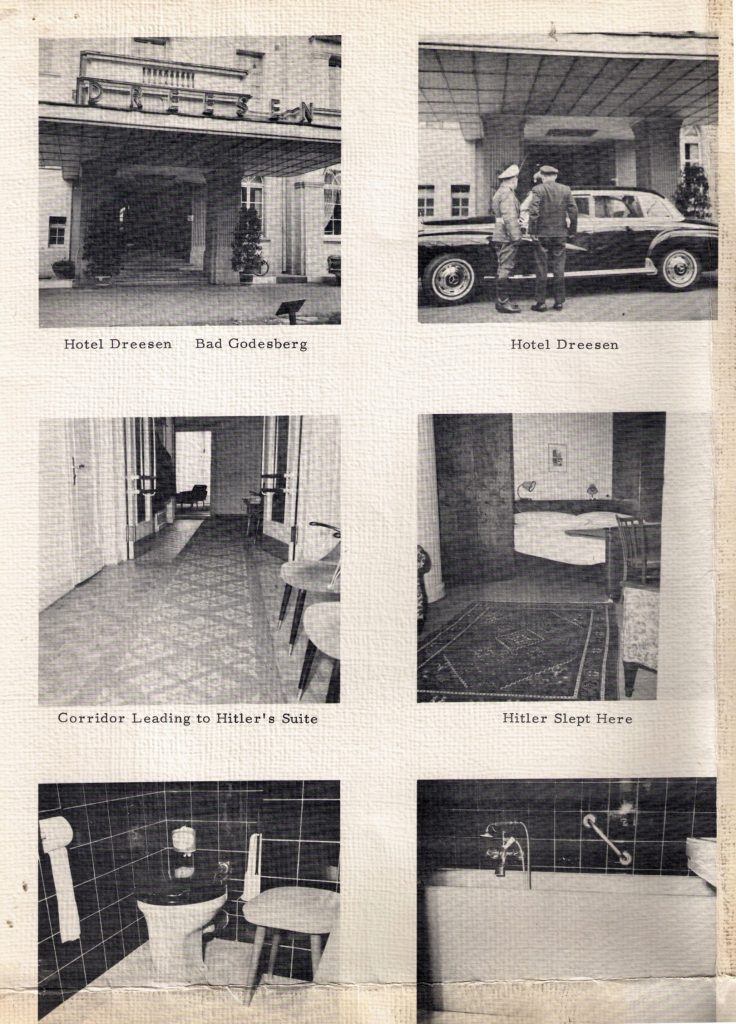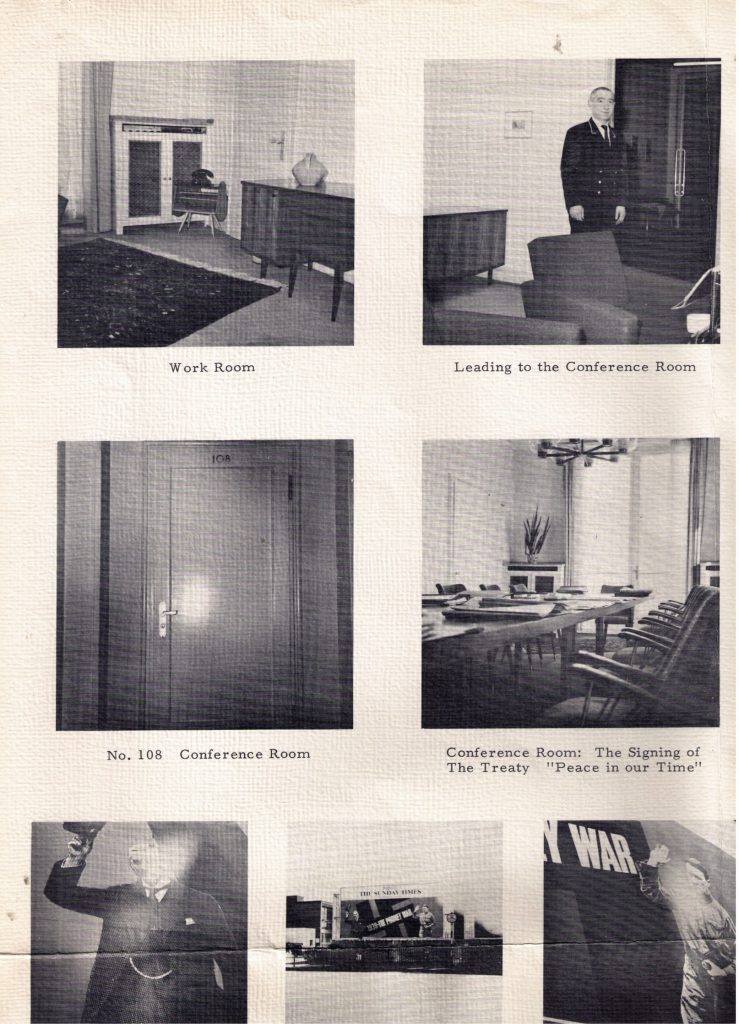Hitler’s Suite at Hotel Dreesen, Bad Godesberg
A visit to Bad Godesberg and interview with Fritz Dreesen


On my way in Bonn, where I had the opportunity to speak to Chancellor Dr. Konrad Adenauer for a very short period, receiving his autographed photograph through the cordiality of his Secretary Ministerialdirigent Herr Selbach, I decided to go to Bad Godesberg/Rhein, to the Hotel Dreesen, where Chamberlain and Hitler signed the treaty which proved so fatal to the entire world. It was here that Chamberlain was fooled by Herr Hitler – “PEACE IN OUR TIME.”
The owner of the Hotel, Fritz Dreesen, gave me permission to occupy the suite where Hitler stayed from 1926 on; the Hotel later became his Headquarters. I actually stayed in his rooms from 9:00 o’clock in the morning until about 2:30 in the afternoon. I took over forty photographs and interviewed Dreesen and quite a number of people who supplied me with many details and much private information.
Dreesen had held a post at the Great Central Hotel in London from 1928 until 1931. He was called up in the early years of the War, the father carrying on the business until he died in 1944, when Dreesen, the son, took over.
Hitler had occupied an adjoining bedroom, workroom and conference room, Nos. 106, 107 and 108, respectively, on the first floor (in the States it would be the second floor). Throughout the meetings Dreesen himself accompanied Chamberlain to this first floor, using the stairway instead of the elevator. Hitler was always very polite and Dreesen talked to him daily. During this time Hitler seemed to be on the edge of a nervous breakdown. On more than one occasion he lost control of himself completely, hurling himself to the floor and chewing the edge of the carpet. Hence the term “teppechfresser” (carpet eater).
Chamberlain came to the Hotel Dreesen for the signing of the famed treaty, remaining there from Wednesday until Saturday, with the exception of Thursday. The conferences lasted one hour, two hours and one hour, respectively – altogether five or six hours. During the conferences, 20-30,000 people, as Dreesen expressed it, “haben gejuebelt and gebuielt” (jubilated and roared) outside the Hotel. Hitler had daily talks with the top brass who came to see him regularly in his suite. Dreesen knew them well – Hess, Goering, Goebbels, Von Ribbentrop, Dr. Ley, as well as other officials and dignitaries. The only one Dreesen did not see was Julius Streicher, although he knew Hitler and Streicher were “gute Freunde” (good friends). Dr. Ley was always “betrunken” (drunk).
Eva Braun also stayed at the Hotel but never when Hitler was present. Many times, after Hitler’s departure, she occupied his rooms. From the conversations Dreesen had with both Hitler and Eva Braun, they seemed to have been very much in love with each other. She was very good looking and well dressed, but not extravagant. Once when she was leaving the Hotel, she asked Dreesen to have a parcel sent to her address in Munich. He mentioned that he, himself, was going to Munich the following week and would gladly take the parcel with him. When looking for the address on his arrival, an eight year old boy directed him to her house with the remark, “do wohnt – Hitler’s Evchen.” Everyone knew of their friendship, while no one knew of it in Godesberg. The two were always together in Salzburg, but never in Godesberg. Goering sometimes arrived with his second wife, Sonnemann.
I asked Dreesen whether he used to give the “Hitlergruss” (Hitler salute). Yes, of course. Just like everyone else. Whether he had heard of concentration camps and people getting killed. Yes, at that time there was Dachau, but not people getting killed. We never heard of Auschwitz and other extermination camps until after the War.
How was it that his hotel was chosen as the residence and eventual headquarters of Hitler and his dignitaries? Well, Rudolf Hess had lived in Godesberg all his life and in 1926 he approached Hitler, “Das ist ein nettes Hotel.” So Hitler, Goering and Goebels went to Godesberg. Did Hitler have any money then? Yes, he had money and paid his bills, from 1926 on.
Before the War Dreesen had many Jewish patrons. One very prominent family by the name of Neumann from Dortmund stayed regularly, even when the National Socialist Party became powerful. These officials, in those early times, approached Dressen, “wir wuenschen mit Juden nicht unter einem Dach” (we do not wish to be under one roof with Jews), to which Dreesen replied, “Es sind alles meine Gäste” (they are all my guests). However, as time went on and THE Party was becoming more powerful, there was no longer any hope of Jews being able to stay at his Hotel.
Dreesen told me that one morning before the War he received a phone call from Neumann that he was in danger And Dreesen arranged to send Neumann by car over the border into Switzerland.
Hitler did not believe in God. Once – as a Catholic – he went to a church and remarked, “They don’t want me here; I don’t belong here.” Similarly, once he visited a Protestant church, saying, “I don’t belong here either.”
But once he was heard mentioning God. That was when he was in conference with Mussolini and, upon hearing that he was over the Brenner Pass, exclaimed, “Gott sei Dank, er ist uber die Grenze” (Thanks to God, he is over the frontier). Hitler neither drank nor smoke but on this occasion he took a sip of champagne.
Asked whether Dreesen believed the Germans would win the War, yes, he and everyone else believed so. When one hears day in and day out the Germans news you cannot believe anything else. It was the propaganda, the radio, the newspaper “für die Heimat.” Hitler could speak no other language but German. However, he was very shrewd and clever in military affairs, knowing everything about warfare down to the smallest detail.
It was with mixed feelings that I sat down and made this report at the very same table in Room 108 where two great leaders made up a resolution and affixed their signatures.
After having interviewed many people and taken photographs and obtaining various cards, mementoes, etc. in connection with the Arch Enemy No. 1, through whom 55 million CIVILIANS (!) perished between 1939 and 1945, I proceeded to.
Excerpt from Frankenhuis Collection Memoirs, Volume 24